The Function of Color and Structure Based on EEG Features in Landscape Recognition
Abstract
:1. Introduction
- (1).
- The recognition accuracy of different colors, structures, and landscape types varies, whereas the classification accuracy for different scenarios in different landscapes is similar;
- (2).
- Color and structure play different roles in different landscape types;
- (3).
- The distribution of brain regions is different in different scenarios and landscape types.
2. Materials and Methods
2.1. Materials
2.2. Subjects
2.3. Method
2.4. Statistical Analysis
3. Results
3.1. Recognition Accuracy of Landscape, Structure, and Color Based on Brain Waves
3.2. Weight and Brain Distribution of Structure and Color in Landscape Recognition
3.3. Analysis of Different Landscapes and Scenarios Based on EEG Features
4. Discussion
4.1. Recognition Accuracy of Landscape, Structure, and Color Based on Machine Learning
4.2. Role of Color and Structure in Landscape Identification
5. Conclusions
Author Contributions
Funding
Institutional Review Board Statement
Informed Consent Statement
Data Availability Statement
Acknowledgments
Conflicts of Interest
Appendix A
| Classifier | Variable (Scenario) | Forest | Desert | Water | ||||||
|---|---|---|---|---|---|---|---|---|---|---|
| Goodness of Fit | Sensitivity | Specificity | Goodness of Fit | Sensitivity | Specificity | Goodness of Fit | Sensitivity | Specificity | ||
| Alpha_SVM | 0.842 | 0.838 | 0.597 | |||||||
| SVM | Landscape | 0.958 | 0.988 | 0.942 | 0.946 | 0.825 | 0.971 | |||
| SVM | Structure | 1.000 | 0.954 | 0.950 | 0.971 | 1.000 | 0.992 | |||
| SVM | Color | 0.892 | 0.983 | 0.942 | 1.000 | 0.933 | 0.917 | |||
| Beta_SVM | 0.952 | 0.770 | 0.780 | |||||||
| SVM | Landscape | 1.000 | 1.000 | 0.983 | 0.946 | 1.000 | 0.942 | |||
| SVM | Structure | 1.000 | 0.950 | 1.000 | 1.000 | 0.950 | 1.000 | |||
| SVM | Color | 0.900 | 1.000 | 0.892 | 0.992 | 0.892 | 0.979 | |||
| Gamma_SVM | 0.944 | 0.912 | 0.971 | |||||||
| SVM | Landscape | 1.000 | 0.975 | 0.992 | 0.975 | 0.992 | 0.988 | |||
| SVM | Structure | 0.942 | 0.971 | 0.983 | 1.000 | 0.967 | 0.988 | |||
| SVM | Color | 0.942 | 0.996 | 0.967 | 0.996 | 0.983 | 0.996 | |||
| Alpha_RF | 0.365 | 0.672 | 0.481 | |||||||
| RF | Landscape | 0.800 | 0.925 | 0.817 | 0.883 | 0.875 | 0.917 | |||
| RF | Structure | 0.967 | 0.917 | 0.858 | 0.896 | 0.975 | 0.983 | |||
| RF | Color | 0.700 | 0.892 | 0.883 | 1.000 | 0.800 | 0.925 | |||
| Beta_RF | 0.938 | 0.639 | 0.778 | |||||||
| RF | Landscape | 0.967 | 0.992 | 0.925 | 0.933 | 0.983 | 0.942 | |||
| RF | Structure | 1.000 | 0.971 | 0.992 | 1.000 | 0.925 | 0.979 | |||
| RF | Color | 0.958 | 1.000 | 0.875 | 0.963 | 0.883 | 0.975 | |||
| Gamma_RF | 0.924 | 0.787 | 0.824 | |||||||
| RF | Landscape | 0.983 | 0.975 | 1.000 | 0.942 | 0.992 | 0.921 | |||
| RF | Structure | 0.917 | 0.996 | 1.000 | 1.000 | 0.875 | 0.983 | |||
| RF | Color | 0.992 | 0.975 | 0.883 | 1.000 | 0.917 | 0.988 | |||
| Alpha_KNN | 0.430 | 0.437 | 0.468 | |||||||
| KNN | Landscape | 0.867 | 0.850 | 0.650 | 0.858 | 0.758 | 0.938 | |||
| KNN | Structure | 0.917 | 0.929 | 0.800 | 0.829 | 0.900 | 0.958 | |||
| KNN | Color | 0.700 | 0.963 | 0.817 | 0.946 | 0.883 | 0.875 | |||
| Beta_KNN | 0.655 | 0.744 | 0.823 | |||||||
| KNN | Landscape | 0.833 | 0.967 | 0.975 | 0.929 | 0.983 | 0.963 | |||
| KNN | Structure | 1.000 | 0.971 | 0.992 | 0.988 | 0.992 | 1.000 | |||
| KNN | Color | 0.933 | 0.946 | 0.867 | 1.000 | 0.925 | 0.988 | |||
| Gamma_KNN | 0.819 | 0.708 | 0.835 | |||||||
| KNN | Landscape | 0.950 | 0.950 | 1.000 | 0.917 | 0.958 | 0.971 | |||
| KNN | Structure | 0.942 | 1.000 | 1.000 | 1.000 | 0.950 | 0.971 | |||
| KNN | Color | 0.958 | 0.975 | 0.833 | 1.000 | 0.925 | 0.975 |
| Classifier | Variable (Landscape Type) | Landscape Images | Structure Images | Color Images | ||||||
|---|---|---|---|---|---|---|---|---|---|---|
| Goodness of Fit | Sensitivity | Specificity | Goodness of Fit | Sensitivity | Specificity | Goodness of Fit | Sensitivity | Specificity | ||
| Alpha_SVM | 0.642 | 0.331 | 0.780 | |||||||
| SVM | Forest | 0.842 | 0.938 | 0.783 | 0.892 | 0.950 | 0.992 | |||
| SVM | Desert | 0.975 | 0.954 | 0.842 | 0.950 | 0.892 | 0.938 | |||
| SVM | Water | 0.900 | 0.967 | 0.750 | 0.846 | 0.867 | 0.925 | |||
| Beta_SVM | 0.825 | 0.911 | 0.883 | |||||||
| SVM | Forest | 0.942 | 0.983 | 0.933 | 0.988 | 1.000 | 0.988 | |||
| SVM | Desert | 1.000 | 1.000 | 0.933 | 0.958 | 0.950 | 0.954 | |||
| SVM | Water | 0.967 | 0.971 | 0.975 | 0.975 | 0.883 | 0.975 | |||
| Gamma_SVM | 0.960 | 0.901 | 0.920 | |||||||
| SVM | Forest | 1.000 | 0.975 | 0.942 | 0.979 | 1.000 | 0.992 | |||
| SVM | Desert | 0.958 | 0.996 | 0.950 | 0.925 | 1.000 | 0.950 | |||
| SVM | Water | 0.983 | 1.000 | 0.908 | 0.996 | 0.883 | 1.000 | |||
| Alpha_RF | 0.460 | 0.281 | 0.460 | |||||||
| RF | Forest | 0.725 | 0.850 | 0.817 | 0.825 | 0.758 | 0.950 | |||
| RF | Desert | 0.817 | 0.913 | 0.800 | 0.863 | 0.733 | 0.888 | |||
| RF | Water | 0.867 | 0.942 | 0.558 | 0.900 | 0.808 | 0.813 | |||
| Beta_RF | 0.663 | 0.653 | 0.617 | |||||||
| RF | Forest | 0.800 | 0.983 | 0.950 | 0.929 | 0.933 | 0.925 | |||
| RF | Desert | 0.958 | 0.971 | 0.892 | 0.933 | 0.858 | 0.938 | |||
| RF | Water | 0.975 | 0.913 | 0.783 | 0.950 | 0.792 | 0.929 | |||
| Gamma_RF | 0.931 | 0.946 | 0.874 | |||||||
| RF | Forest | 0.992 | 0.988 | 0.958 | 1.000 | 1.000 | 0.971 | |||
| RF | Desert | 0.958 | 1.000 | 1.000 | 0.963 | 0.967 | 0.967 | |||
| RF | Water | 0.983 | 0.979 | 0.958 | 0.996 | 0.892 | 0.992 | |||
| Alpha_KNN | 0.208 | 0.086 | 0.384 | |||||||
| KNN | Forest | 0.667 | 0.713 | 0.725 | 0.771 | 0.650 | 0.888 | |||
| KNN | Desert | 0.717 | 0.867 | 0.733 | 0.904 | 0.583 | 0.900 | |||
| KNN | Water | 0.650 | 0.938 | 0.475 | 0.792 | 0.892 | 0.775 | |||
| Beta_KNN | 0.320 | 0.534 | 0.541 | |||||||
| KNN | Forest | 0.575 | 0.942 | 0.858 | 0.900 | 0.833 | 0.925 | |||
| KNN | Desert | 0.967 | 0.950 | 0.933 | 0.975 | 0.900 | 0.967 | |||
| KNN | Water | 0.917 | 0.838 | 0.850 | 0.946 | 0.875 | 0.913 | |||
| Gamma_KNN | 0.592 | 0.879 | 0.720 | |||||||
| KNN | Forest | 0.775 | 0.992 | 0.942 | 0.979 | 0.925 | 0.888 | |||
| KNN | Desert | 1.000 | 1.000 | 0.950 | 0.967 | 0.825 | 0.954 | |||
| KNN | Water | 0.983 | 0.888 | 0.958 | 0.979 | 0.892 | 0.979 | |||
References
- Schafer, P.J.; Serman, M.; Arnold, M.; Corona-Strauss, F.I.; Strauss, D.J.; Seidler-Fallbohmer, B.; Seidler, H. Evaluation of an objective listening effort measure in a selective, multi-speaker listening task using different hearing aid settings. Conf. Proc. IEEE Eng. Med. Biol. Soc. 2015, 4647–4650. [Google Scholar] [CrossRef]
- Keshavarz, B.; Campos, J.L.; Berti, S. Vection lies in the brain of the beholder: EEG parameters as an objective measurement of vection. Front. Psychol. 2015, 6, 1581. [Google Scholar] [CrossRef] [Green Version]
- Norwood, M.F.; Lakhani, A.; Maujean, A.; Zeeman, H.; Kendall, E. Brain activity, underlying mood and the environment: A systematic review. J. Environ. Psychol. 2019, 65, 101321. [Google Scholar] [CrossRef]
- Teplan, M. Fundamentals of EEG measurement. Meas. Sci. Rev. 2002, 2, 1–11. [Google Scholar]
- Whalen, P.J.; Rauch, S.L.; Etcoff, N.L.; McInerney, S.C.; Lee, M.B.; Jenike, M.A. Masked Presentations of Emotional Facial Expressions Modulate Amygdala Activity without Explicit Knowledge. J. Neurosci. 1998, 18, 411–418. [Google Scholar] [CrossRef]
- Chang, C.Y.; Hammitt, W.E.; Chen, P.K.; Machnik, L.; Su, W.C. Psychophysiological responses and restorative values of natural environments in Taiwan. Landsc. Urban Plan. 2008, 85, 79–84. [Google Scholar] [CrossRef]
- Martínez-Soto, J.; Gonzales-Santos, L.; Pasaye, E.; Barrios, F.A. Exploration of neural correlates of restorative environment exposure through functional magnetic resonance. Intell. Build. Int. 2013, 5, 10–28. [Google Scholar] [CrossRef]
- Bear, M.; Connors, B.; Paradiso, M. Neuroscience: Exploring the Brain; Jones & Bartlett Learning: Burlington, ON, Canada, 2015. [Google Scholar]
- Moon, S.E.; Chen, C.J.; Hsieh, C.J.; Wang, J.L.; Lee, J.S. Emotional EEG classification using connectivity features and convolutional neural networks. Neural Netw. 2020, 132, 96–107. [Google Scholar] [CrossRef]
- Liu, S.; Tong, J.; Meng, J.; Yang, J.; Zhao, X.; He, F.; Qi, H.; Ming, D. Study on an effective cross-stimulus emotion recognition model using EEGs based on feature selection and support vector machine. Int. J. Mach. Learn. Cybern. 2018, 9, 721–726. [Google Scholar] [CrossRef]
- Li, J.; Zhang, Z.; He, H. Hierarchical convolutional neural networks for EEG-based emotion recognition. Cogn. Comput. 2018, 10, 368–380. [Google Scholar] [CrossRef]
- Shahabi, H.; Moghimi, S. Toward automatic detection of brain responses to emotional music through analysis of EEG effective connectivity. Comput. Hum. Behav. 2016, 58, 231–239. [Google Scholar] [CrossRef]
- Zheng, W.L.; Lu, B.L. Investigating critical frequency bands and channels for EEG-based emotion recognition with deep neural networks. IEEE Tran. Auton. Ment. Dev. 2015, 7, 162–175. [Google Scholar] [CrossRef]
- Khasnobish, A.; Konar, A.; Tibarewala, D.; Bhattacharyya, S.; Janarthanan, R. Object shape recognition from EEG signals during tactile and visual exploration. In Proceedings of the International Conference on Pattern Recognition and Machine Intelligence, Kolkata, India, 10–14 December 2013; pp. 459–464. [Google Scholar] [CrossRef] [Green Version]
- Rus, I.D.; Marc, P.; Dinsoreanu, M.; Potolea, R.; Muresan, R.C. Classification of EEG signals in an object recognition task. In Proceedings of the 2017 13th IEEE International Conference on Intelligent Computer Communication and Processing (ICCP), Cluj-Napoca, Romania, 7–9 September 2017; pp. 391–395. [Google Scholar] [CrossRef]
- Rasheed, S.; Marini, D. Classification of EEG signals produced by RGB colour stimuli. J. Biomed. Eng. Med. 2015, 2, 56. [Google Scholar] [CrossRef]
- Lam, Q.C.; Nguyen, L.A.T.; Nguyen, H.K. EEG Signal Identification Using Single-Layer Neural Network. Int J. Cybern. Inform. 2016, 5, 1–10. [Google Scholar] [CrossRef]
- Roe, J.J.; Aspinall, P.A.; Mavros, P.; Coyne, R. Engaging the brain: The impact of natural versus urban scenes using novel EEG methods in an experimental setting. Environ. Sci. 2013, 1, 93–104. [Google Scholar] [CrossRef] [Green Version]
- Tilley, S.; Neale, C.; Patuano, A.; Cinderby, S. Older People’s Experiences of Mobility and Mood in an Urban Environment: A Mixed Methods Approach Using Electroencephalography (EEG) and Interviews. Int. J. Environ. Res. Public Health 2017, 14, 151. [Google Scholar] [CrossRef] [PubMed]
- Ulrich, R.S. Natural versus urban scenes: Some psychophysiological effects. Environ. Behav. 1981, 13, 523–556. [Google Scholar] [CrossRef]
- Chiang, Y.C.; Li, D.Y.; Jane, H.A. Wild or tended nature? The effects of landscape location and vegetation density on physiological and psychological responses. Landsc. Urban Plan. 2017, 167, 72–83. [Google Scholar] [CrossRef]
- Qin, J.; Zhou, X.; Sun, C.; Leng, H.; Lian, Z. Influence of green spaces on environmental satisfaction and physiological status of urban residents. Urban For. Urban Green. 2013, 12, 490–497. [Google Scholar] [CrossRef]
- Sacchelli, S.; Grilli, G.; Capecchi, I.; Bambi, L.; Barbierato, E.; Borghini, T. Neuroscience Application for the Analysis of Cultural Ecosystem Services Related to Stress Relief in Forest. Forests 2020, 11, 190. [Google Scholar] [CrossRef] [Green Version]
- Elliot, A.J.; Maier, M.A.; Moller, A.C.; Friedman, R.; Meinhardt, J.R. Color and psychological functioning: The effect of red on performance attainment. J. Expt. Psychol. Gen. 2007, 136, 154–168. [Google Scholar] [CrossRef] [Green Version]
- Palmer, S.E.; Schloss, K.B. An ecological valence theory of human color preference. Proc. Natl. Acad. Sci. USA 2010, 107, 8877–8882. [Google Scholar] [CrossRef] [Green Version]
- Freiders, S.; Lee, S.; Statz, D.; Kim, T. The Influence of Color on Physiological Response. J. Adv. Stud. Sci. 2012, 1, 1–12. [Google Scholar]
- Kim, J.Y.; Lee, H.S. A study on interior wall color based on measurement of emotional responses. Sci. Emot. Sensib. 2009, 12, 205–214. [Google Scholar]
- Lancaster, M. Colourscape; Academy Editions: London, UK, 1996. [Google Scholar]
- Biederman, I. Recognition-by-components: A theory of human image understanding. Psychol. Rev. 1987, 94, 115–147. [Google Scholar] [CrossRef] [Green Version]
- Biederman, I.; Ju, G. Surface versus edge-based determinants of visual recognition. Cogn. Psychol. 1988, 20, 38–64. [Google Scholar] [CrossRef] [Green Version]
- Tanaka, J.; Weiskopf, D.; Williams, P. The role of color in high-level vision. Trends Cogn. Sci. 2001, 5, 211–215. [Google Scholar] [CrossRef]
- Inês Bramão, L.F.; Petersson, K.M.; Reis, A. The Contribution of Color to Object Recognition; InTech: Rijeka, Croatia, 2012. [Google Scholar]
- Bramão, I.; Faísca, L.; Forkstam, C.; Reis, A.; Petersson, K.M. Cortical brain regions associated with color processing: An FMRI study. Open Neuroimag. J. 2010, 4, 164–173. [Google Scholar] [CrossRef] [PubMed] [Green Version]
- Zhang, X.J.; Chen, J.; Li, Q.Y.; Liu, J.C.; Tao, J.P. Color quantification and evaluation of landscape aesthetic quality for autumn landscape forest based on visual characteristics in subalpine region of western Sichuan, China. Yingyong Shengtai Xuebao 2020, 31, 45–54. [Google Scholar] [CrossRef]
- Deng, S.; Yan, J.; Guan, Q.; Katoh, M. Short-term effects of thinning intensity on scenic beauty values of different stands. J. For. Res. 2013, 18, 209–219. [Google Scholar] [CrossRef]
- Tang, I.C.; Tsai, Y.P.; Lin, Y.J.; Chen, J.H.; Hsieh, C.H.; Hung, S.H.; Sullivan, W.C.; Tang, H.F.; Chang, C.Y. Using functional Magnetic Resonance Imaging (fMRI) to analyze brain region activity when viewing landscapes. Landsc. Urban Plan. 2017, 162, 137–144. [Google Scholar] [CrossRef]
- Balconi, M.; Molteni, E. Past and future of near-infrared spectroscopy in studies of emotion and social neuroscience. J. Cogn. Psychol. 2016, 28, 129–146. [Google Scholar] [CrossRef]
- Matsubara, T.; Matsuo, K.; Hirata, K.; Harada, K.; Hirotsu, M.; Watanuki, T.; Watanabe, Y.; Nakagawa, S. F150. Neurofeedback of frontal response to emotional sentence in healthy subjects: A functional near-infrared spectroscopy study. Biol. Psychiatry 2018, 83, S296. [Google Scholar] [CrossRef]
- Pivik, R.T.; Broughton, R.J.; Coppola, R.; Davidson, R.J.; Fox, N.; Nuwer, M.R. Guidelines for the recording and quantitative analysis of electroencephalographic activity in research contexts. Psychophysiology 1993, 30, 547–558. [Google Scholar] [CrossRef]
- Keil, A.; Debener, S.; Gratton, G.; Junghöfer, M.; Kappenman, E.S.; Luck, S.J.; Luu, P.; Miller, G.A.; Yee, C.M. Committee report: Publication guidelines and recommendations for studies using electroencephalography and magnetoencephalography. Psychophysiology 2014, 51, 1–21. [Google Scholar] [CrossRef]
- Fridlund, A.J.; Cacioppo, J.T. Guidelines for human electromyographic research. Psychophysiology 1986, 23, 567–589. [Google Scholar] [CrossRef]
- Gabard-Durnam, L.J.; Wilkinson, C.; Kapur, K.; Tager-Flusberg, H.; Levin, A.R.; Nelson, C.A. Longitudinal EEG power in the first postnatal year differentiates autism outcomes. Nat. Commun. 2019, 10, 1–12. [Google Scholar] [CrossRef] [PubMed]
- Conneau, A.C.; Essid, S. Assessment of new spectral features for eeg-based emotion recognition. In Proceedings of the 2014 IEEE International Conference on Acoustics, Speech and Signal Processing (ICASSP), Florence, Italy, 4–9 May2014. [Google Scholar] [CrossRef]
- Braboszcz, C.; Cahn, B.R.; Levy, J.; Fernandez, M.; Delorme, A. Increased Gamma Brainwave Amplitude Compared to Control in Three Different Meditation Traditions. PLoS ONE 2017, 12, e0170647. [Google Scholar] [CrossRef] [PubMed]
- Choi, Y.; Kim, M.; Chun, C. Measurement of occupants’ stress based on electroencephalograms (EEG) in twelve combined environments. Build. Environ. 2015, 88, 65–72. [Google Scholar] [CrossRef]
- Sanei, S.; Chambers, J.A. EEG Signal Processing; John Wiley & Sons Ltd.: West Sussex, UK, 2007. [Google Scholar]
- Chang, C.C.; Lin, C.J. LIBSVM: A library for support vector machines. ACM Trans. Intell. Syst. Technol. (TIST) 2011, 2, 1–27. [Google Scholar] [CrossRef]
- Johnson, J.W. Factors affecting relative weights: The influence of sampling and measurement error. Organ. Res. Methods 2004, 7, 283–299. [Google Scholar] [CrossRef]
- Johnson, J.W.; LeBreton, J.M. History and use of relative importance indices in organizational research. Organ. Res. Methods 2004, 7, 238–257. [Google Scholar] [CrossRef]
- LeBreton, J.M.; Tonidandel, S. Multivariate relative importance: Extending relative weight analysis to multivariate criterion spaces. J. Appl. Psychol. 2008, 93, 329. [Google Scholar] [CrossRef] [PubMed]
- Johnson, J.W. A heuristic method for estimating the relative weight of predictor variables in multiple regression. Multivar. Behav. Res. 2000, 35, 1–19. [Google Scholar] [CrossRef] [PubMed]
- Yuvaraj, R.; Murugappan, M.; Ibrahim, N.M.; Sundaraj, K.; Omar, M.I.; Mohamad, K.; Palaniappan, R. Optimal set of EEG features for emotional state classification and trajectory visualization in Parkinson’s disease. Int. J. Psychophys. 2014, 94, 482–495. [Google Scholar] [CrossRef]
- Balconi, M.; Lucchiari, C. Consciousness and arousal effects on emotional face processing as revealed by brain oscillations. A gamma band analysis. Int. J. Psychophys. 2008, 67, 41–46. [Google Scholar] [CrossRef]
- Bos, D.O. EEG-based emotion recognition. Influ. Vis. Audit. 2006, 56, 1–17. [Google Scholar]
- Keil, A.; Müller, M.M.; Gruber, T.; Wienbruch, C.; Stolarova, M.; Elbert, T. Effects of emotional arousal in the cerebral hemispheres: A study of oscillatory brain activity and event-related potentials. Clin. Neurophysiol. 2001, 112, 2057–2068. [Google Scholar] [CrossRef] [Green Version]
- Jiang, B.; Chang, C.Y.; Sullivan, W.C. A dose of nature: Tree cover, stress reduction, and gender differences. Landsc. Urban Plan. 2014, 132, 26–36. [Google Scholar] [CrossRef]
- Kim, M.; Cheon, S.; Kang, Y. Use of Electroencephalography (EEG) for the Analysis of Emotional Perception and Fear to Nightscapes. Sustainability 2019, 11, 233. [Google Scholar] [CrossRef] [Green Version]
- Qiu, L.; Lindberg, S.; Nielsen, A.B. Is biodiversity attractive?—On site perception of recreational and biodiversity values in urban green space. Landsc. Urban Plan. 2013, 119, 136–146. [Google Scholar] [CrossRef]

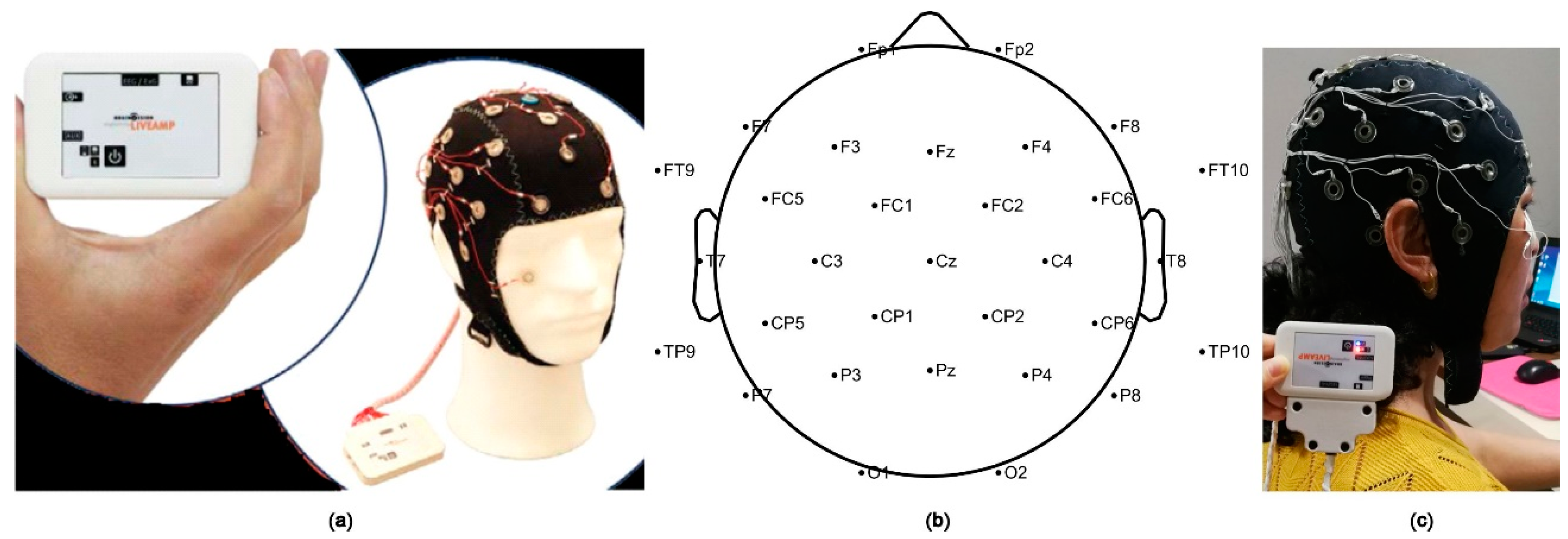

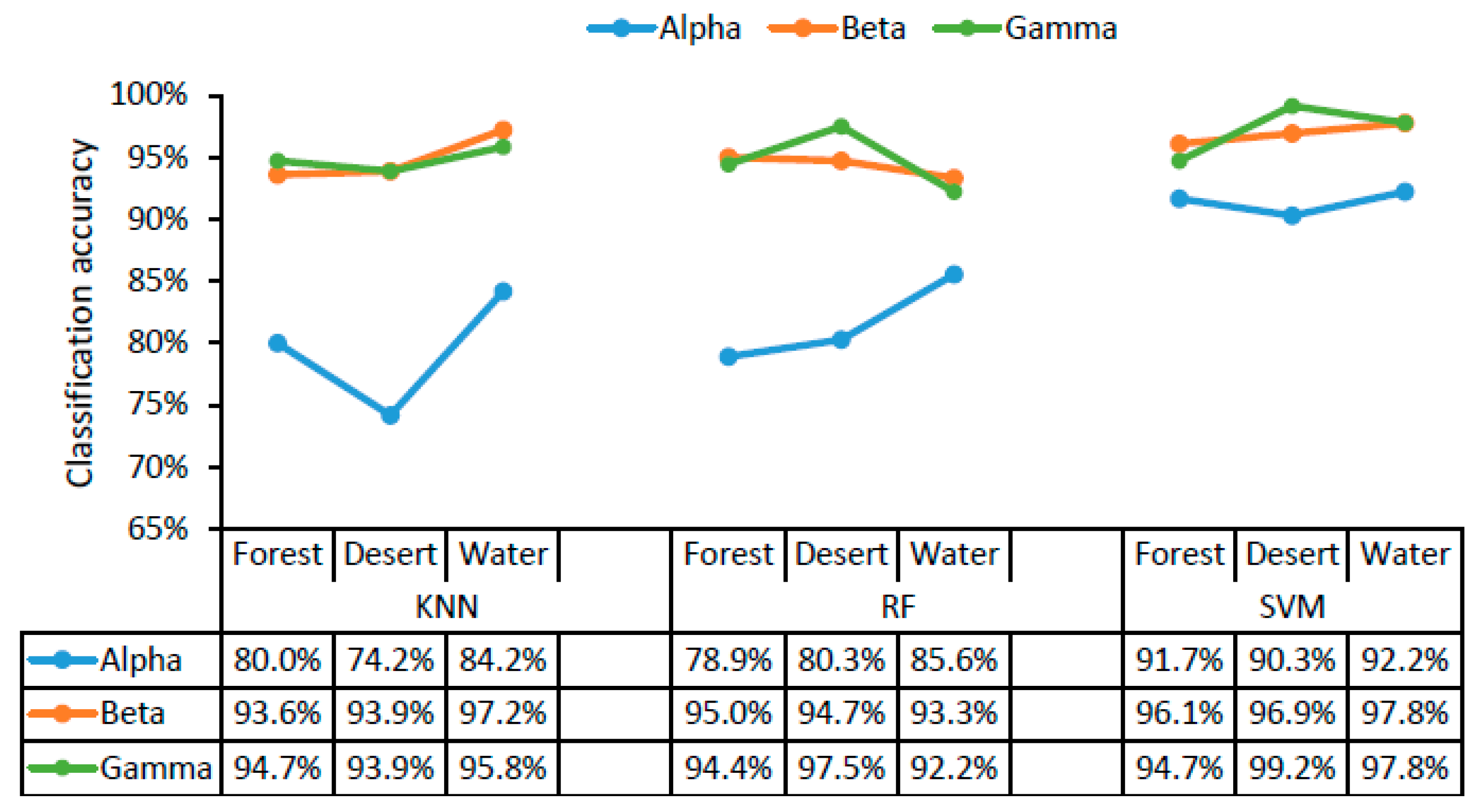
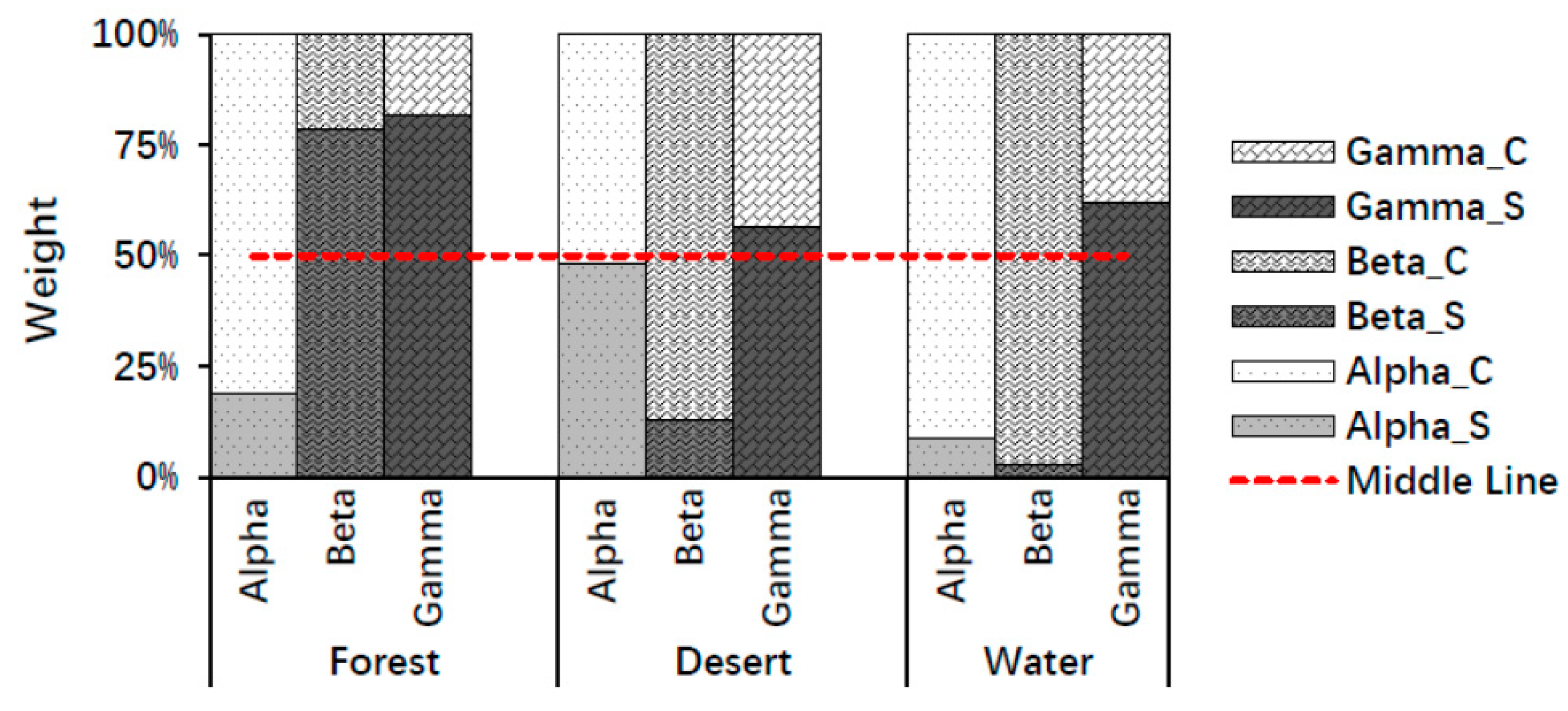
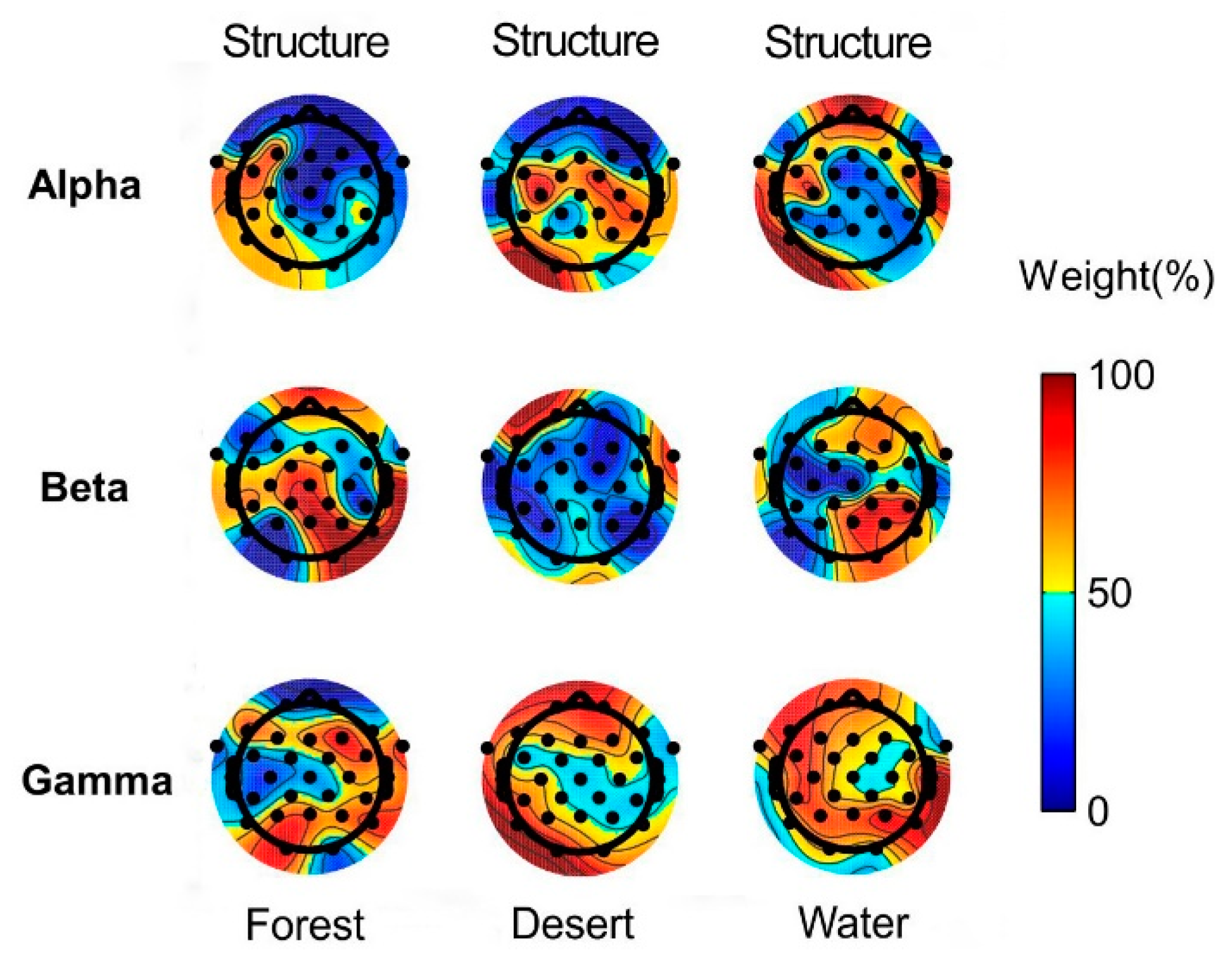

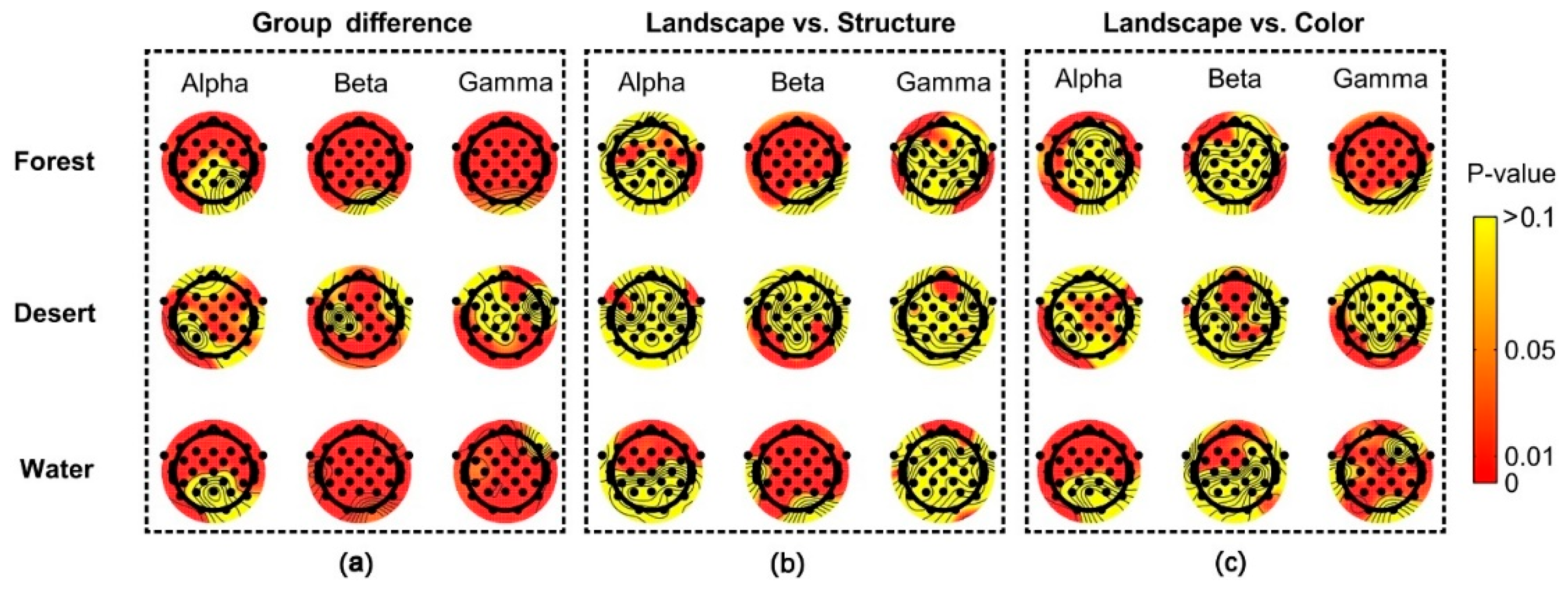
| Factor | Df | SumSq | MeanSq | F_value | Pr (>F) |
|---|---|---|---|---|---|
| Alpha wave | |||||
| Scenario | 2 | 0.31 | 0.15 | 4.67 | 0.01 * |
| Landscape | 2 | 0.09 | 0.04 | 1.35 | 0.26 |
| Scenario: Landscape | 4 | 1.41 | 0.35 | 10.70 | 0.00 *** |
| Residuals | 171 | 5.62 | 0.03 | ||
| Beta wave | |||||
| Scenario | 2 | 0.16 | 0.08 | 11.54 | 0.00 *** |
| Landscape | 2 | 0.12 | 0.06 | 8.47 | 0.00 *** |
| Scenario: Landscape | 4 | 0.06 | 0.01 | 2.09 | 0.08 • |
| Residuals | 171 | 1.16 | 0.01 | ||
| Gamma wave | |||||
| Scenario | 2 | 0.34 | 0.17 | 15.42 | 0.00 *** |
| Landscape | 2 | 0.01 | 0.01 | 0.61 | 0.55 |
| Scenario: Landscape | 4 | 0.15 | 0.04 | 3.35 | 0.01 * |
| Residuals | 171 | 1.90 | 0.01 | ||
Publisher’s Note: MDPI stays neutral with regard to jurisdictional claims in published maps and institutional affiliations. |
© 2021 by the authors. Licensee MDPI, Basel, Switzerland. This article is an open access article distributed under the terms and conditions of the Creative Commons Attribution (CC BY) license (https://creativecommons.org/licenses/by/4.0/).
Share and Cite
Wang, Y.; Wang, S.; Xu, M. The Function of Color and Structure Based on EEG Features in Landscape Recognition. Int. J. Environ. Res. Public Health 2021, 18, 4866. https://doi.org/10.3390/ijerph18094866
Wang Y, Wang S, Xu M. The Function of Color and Structure Based on EEG Features in Landscape Recognition. International Journal of Environmental Research and Public Health. 2021; 18(9):4866. https://doi.org/10.3390/ijerph18094866
Chicago/Turabian StyleWang, Yuting, Shujian Wang, and Ming Xu. 2021. "The Function of Color and Structure Based on EEG Features in Landscape Recognition" International Journal of Environmental Research and Public Health 18, no. 9: 4866. https://doi.org/10.3390/ijerph18094866
APA StyleWang, Y., Wang, S., & Xu, M. (2021). The Function of Color and Structure Based on EEG Features in Landscape Recognition. International Journal of Environmental Research and Public Health, 18(9), 4866. https://doi.org/10.3390/ijerph18094866





